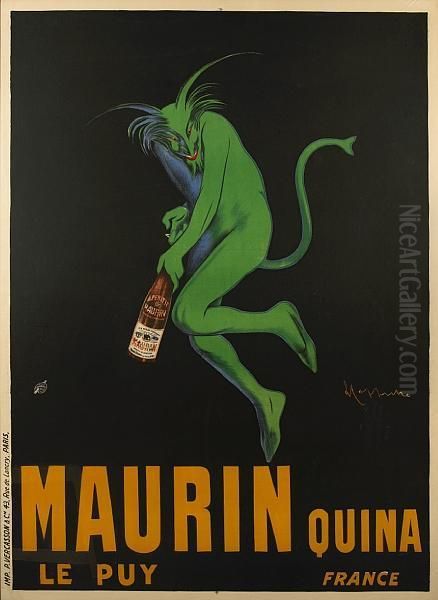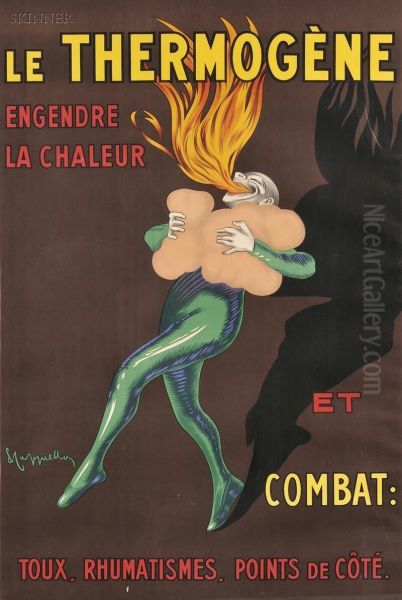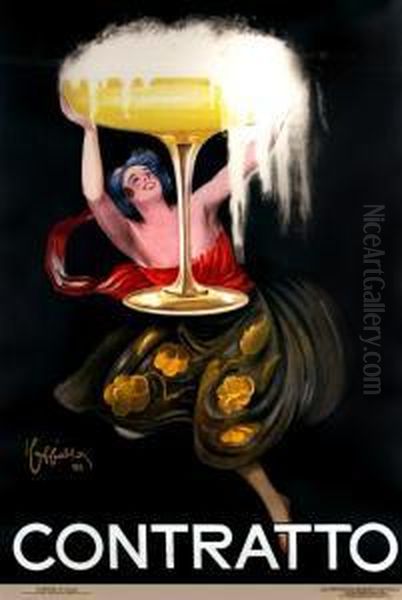Leonetto Cappiello stands as a monumental figure in the history of graphic design, an artist whose innovative vision and distinctive style irrevocably transformed the art of the advertising poster. Born in Italy but flourishing in the vibrant artistic crucible of Paris, Cappiello earned the enduring moniker "the father of modern advertising." His work, characterized by its dynamism, bold use of color, and unforgettable characters, not only captivated the public of his time but also laid a foundational aesthetic for generations of designers to come. This exploration delves into the life, career, artistic innovations, and lasting legacy of a true pioneer.
Early Life and Self-Forged Path
Leonetto Cappiello was born on April 9, 1875, in Livorno, a bustling port city in Tuscany, Italy. His father was a maritime liquidator, and his family background, while respectable, was not steeped in the artistic traditions that often nurture young talents in more established cultural centers. Crucially, Cappiello did not receive formal academic art training at an academy or institution. His artistic education was largely a product of his own keen observation, innate talent, and relentless practice. From a young age, he was an avid sketcher, filling notebooks with drawings and caricatures of the people and scenes around him in Livorno.
This early inclination towards caricature would prove formative. It honed his ability to capture the essence of a subject with a few deft strokes, to exaggerate features for expressive effect, and to inject a sense of life and personality into his figures. Livorno, with its diverse population and lively street life, provided ample material for his burgeoning skills. His reputation as a talented local caricaturist began to grow even before he ventured beyond his hometown. This self-driven approach, unconstrained by academic dogma, allowed him to develop a uniquely personal and direct style that would later define his groundbreaking poster work.

In 1897, at the age of 22, Cappiello made a pivotal decision to visit his brother, who was working at the Paris Stock Exchange. This visit quickly turned into a permanent move. Paris at the turn of the century, during the Belle Époque, was the undisputed cultural capital of the Western world, a magnet for artists, writers, and innovators. It was here, amidst the city's exhilarating artistic ferment, that Cappiello's career would truly ignite.
Parisian Debut: The Caricaturist Ascendant
Upon arriving in Paris, Cappiello initially continued to leverage his talent for caricature. The city boasted a thriving popular press, with numerous illustrated journals and satirical magazines that provided a platform for artists like him. He quickly began to make a name for himself, contributing sharp, witty, and insightful caricatures to prominent publications such as Le Rire, Le Sourire, L'Assiette au Beurre, and Le Cri de Paris. His work from this period often targeted well-known socialites, actors, writers, and politicians, capturing their public personas with an unerring eye for detail and a touch of playful irreverence.
His style was influenced by the masters of French caricature who preceded him, most notably Honoré Daumier, and contemporaries like Jean-Louis Forain and Caran d'Ache. However, the artist whose spirit perhaps resonated most closely with Cappiello's emerging graphic sensibility was Henri de Toulouse-Lautrec. Lautrec, with his bold outlines, flattened perspectives, and dynamic compositions in his posters for Parisian nightlife, had already begun to elevate commercial art. Cappiello absorbed these influences, but always filtered them through his own distinct vision.
In 1901, Cappiello published an album of caricatures titled Gens du Monde (People of Society), which featured 22 satirical portraits critiquing the vanities and affectations of contemporary Parisian high society. This publication further solidified his reputation. His caricatures were not merely humorous; they often carried a subtle social commentary, revealing his astute understanding of human nature. This period was crucial for developing his ability to create instantly recognizable and memorable figures, a skill that would become paramount in his later advertising work.
The Pivotal Shift to Poster Design
While caricature brought him recognition, it was the burgeoning field of poster advertising that would offer Cappiello his true calling and lasting fame. The late 19th and early 20th centuries were a golden age for the poster, thanks to advancements in color lithography pioneered by artists like Jules Chéret, who is often called the "father of the modern poster." Chéret's vibrant, joyful depictions of Parisian life, filled with his iconic, free-spirited female figures known as "Chérettes," had already transformed the city's walls into open-air art galleries.

Cappiello entered this dynamic arena around 1899-1900. His transition was facilitated by his collaboration with the printer Pierre Vercasson, with whom he would work for many years. Vercasson recognized Cappiello's unique talent and provided him with the technical means to translate his bold visions into large-scale lithographic prints. Unlike many of his contemporaries whose work was still heavily influenced by the ornate and decorative tendencies of Art Nouveau, as seen in the elaborate designs of Alphonse Mucha or the more symbolist work of Eugène Grasset, Cappiello began to forge a new path.
He understood instinctively that an effective advertisement needed to grab attention immediately and imprint its message on the viewer's mind in a fleeting moment. This required a departure from complex, detailed imagery towards a more simplified, impactful, and often surprising visual language. His early posters, while sometimes showing traces of Art Nouveau's curvilinear forms, quickly evolved. He began to favor strong, central figures, often fantastical or comically exaggerated, set against stark, usually dark, backgrounds. This allowed the product or the character representing it to "pop" with an almost theatrical intensity.
The Cappiello Style: A Revolution in Advertising
Leonetto Cappiello's mature style, which fully emerged in the first decade of the 20th century, was revolutionary. It marked a decisive break from the prevailing aesthetics and established a new paradigm for advertising art. Several key characteristics defined his innovative approach:
Bold, Surprising Figures: Cappiello populated his posters with an unforgettable cast of characters. These were not merely illustrative representations but often whimsical, energetic, and larger-than-life figures that seemed to leap out from the poster. Whether it was a mischievous green devil for "Maurin Quina" absinthe, an ecstatic woman riding a red horse for "Chocolat Klaus," or a jovial chef for "Bouillon Kub," these figures were designed to be instantly memorable and to create a strong, positive association with the product. He understood the power of branding through character long before it became a standard marketing strategy.
Vibrant Color Against Dark Backgrounds: One of Cappiello's most distinctive innovations was his use of brightly colored figures set against dark, often black or deep blue, backgrounds. This dramatic chiaroscuro effect created an unparalleled visual impact, making his posters stand out amidst the cacophony of urban streetscapes. The vibrant hues of his subjects – fiery reds, electric blues, sunny yellows, and vivid greens – seemed to radiate light, drawing the viewer's eye directly to the central message. This contrasted sharply with the often lighter, more pastel palettes favored by many Art Nouveau artists.

Dynamic Composition and Movement: Cappiello's posters are rarely static. His figures are often depicted in motion – dancing, leaping, riding, or gesticulating with exuberant energy. This sense of dynamism was a deliberate strategy to capture attention and convey excitement and vitality. He used strong diagonals, swirling lines, and a sense of arrested movement to create a feeling of immediacy and animation. This was a significant departure from the more languid, flowing lines typical of Art Nouveau.
Focus on a Single, Powerful Image: Unlike earlier posters that might be cluttered with text or multiple illustrative elements, Cappiello typically focused on a single, dominant image. He believed in the power of the "arabesque on a black background," a striking visual that could communicate its message almost instantaneously. The product itself might be subtly integrated or represented by the character, but the primary goal was to create an unforgettable visual hook. This principle of visual simplicity and directness was groundbreaking.
Humor and Playfulness: A sense of humor and playful charm pervades much of Cappiello's work. His exaggerated figures and whimsical scenarios often elicited a smile, creating a positive emotional connection with the advertised product. This lighthearted approach made his advertisements engaging and approachable, rather than purely didactic or descriptive.
These stylistic innovations collectively contributed to Cappiello's reputation as "the father of modern advertising." He shifted the focus from mere illustration to psychological impact, understanding that an advertisement's success lay in its ability to create desire and brand recognition through memorable and emotionally resonant imagery. His approach was a precursor to many principles of modern branding and visual communication. He influenced a generation of poster artists who followed, including Art Deco masters like A.M. Cassandre, Jean Carlu, and Paul Colin, who built upon his legacy of bold, graphic statements. Even artists working in different but related fields, like the Italian Futurist Fortunato Depero in his advertising designs, or the German Plakatstil (Poster Style) proponents like Lucian Bernhard with their emphasis on product and brand name, shared a common ancestor in Cappiello's drive for visual simplification and impact.
Iconic Works: A Portfolio of Persuasion
Over his prolific career, Leonetto Cappiello produced over 530 advertising posters, in addition to numerous book illustrations, set designs, and paintings. Several of his posters have become iconic, enduring symbols of their era and masterpieces of graphic design.

"Chocolat Klaus" (1903): This is one of Cappiello's earliest and most famous masterpieces. It features a woman in a vibrant green dress, ecstatically riding a fiery red horse against a stark black background, clutching a bar of Chocolat Klaus. The image is pure fantasy and exuberance, conveying the sheer delight of the product rather than any literal representation of chocolate consumption. It perfectly exemplifies his use of dynamic figures, bold color contrast, and emotional appeal.
"Maurin Quina" (1906): Perhaps his most instantly recognizable work, this poster features a mischievous, almost impish green devil uncorking a bottle of the French apéritif. The figure, rendered in a startling shade of green, is both intriguing and slightly risqué, perfectly capturing the allure of the absinthe-based drink. The simplicity of the image and the unforgettable character made it an incredibly effective advertisement.
"Cinzano" (various dates): Cappiello created several iconic posters for the Italian vermouth brand Cinzano. One of the most famous depicts a dashing figure in red, astride a zebra, also rendered in red, against a yellow background. The image is dynamic, stylish, and slightly surreal, associating the brand with sophistication and excitement. This work, like many others, showcases his ability to create a brand identity through recurring visual motifs and characters.
"Thermogène" (1909): Advertising a medicated cotton wool for aches and pains, this poster features a striking image of a green, fire-breathing man, symbolizing the heat-generating properties of the product. The visual is dramatic and immediately communicates the product's benefit in a highly memorable way.
"Bouillon Kub" (1931): For the bouillon cube brand, Cappiello created a robust, cheerful chef figure, often depicted with an oversized Kub box. This character became synonymous with the brand, demonstrating Cappiello's mastery of creating enduring brand mascots.
Other notable works include posters for "Contratto" sparkling wine, featuring a jubilant, champagne-popping figure; "Persil" laundry detergent; "Job" rolling papers; "Pâtes Baroni" (Baroni Pasta), with a chef joyfully tossing pasta; and "Campari l'apéritif," featuring a Pierrot-like figure with a bottle of Campari. Each of these works demonstrates his consistent ability to distill a brand's essence into a single, compelling visual statement. His work for "Folies-Bergère" captured the vivacity of Parisian music halls, while posters like "La Caisse Simon / Huîtres Exquises" brought an unexpected dynamism to food advertising. Even more utilitarian products, as seen in "Chaussures Renul" (Renul Shoes) or "Doctor Ressuel" (for therapeutic candles), were imbued with his characteristic flair.
Art Movements: Beyond Art Nouveau to Modernism
Leonetto Cappiello's career spanned a period of significant artistic transition, from the height of Art Nouveau through the emergence of Art Deco and other modernist currents. While his early work, particularly his caricatures and some initial poster designs, showed an awareness of Art Nouveau's decorative qualities and sinuous lines, he quickly evolved beyond it. Artists like Alphonse Mucha, with his intricate floral motifs and idealized female figures, or Privat Livemont, with his elegant and detailed compositions, represented the quintessential Art Nouveau poster style. Cappiello, however, found this approach too elaborate for the direct impact he sought in advertising.
He consciously moved away from the organic, flowing ornamentation of Art Nouveau. Instead, his work is better understood as a bridge towards Modernism and, specifically, as a significant precursor to the Art Deco style that would flourish in the 1920s and 1930s. Art Deco, with its emphasis on bold geometric forms, streamlined shapes, rich colors, and a sense of modern dynamism, owes a considerable debt to Cappiello's innovations. His focus on simplified, powerful imagery, strong color contrasts, and dynamic compositions anticipated many of Art Deco's core tenets.
While not strictly adhering to any single "movement" for the majority of his career, Cappiello was a modernist in spirit. He embraced new visual strategies to meet the demands of a modern, commercial world. His approach was pragmatic and results-oriented, always focused on effective communication. He can be seen in dialogue with other innovators in poster art, such as the British duo The Beggarstaffs (James Pryde and William Nicholson), who also championed simplified forms and bold silhouettes, albeit with a more muted palette and a different graphic sensibility. His Italian contemporary, Marcello Dudovich, also created elegant and impactful posters, though often with a more refined and less overtly fantastical style.
Influences, Contemporaries, and His Own Pervasive Influence
Cappiello's artistic development was shaped by several key influences. As mentioned, Jules Chéret was a foundational figure in establishing the poster as an art form, and his vibrant use of color and lively figures provided an important precedent. Henri de Toulouse-Lautrec's bold graphic style and his ability to capture the essence of Parisian life in his posters for venues like the Moulin Rouge also left a significant mark, particularly on Cappiello's understanding of dynamic composition and character. Théophile Steinlen, another prolific Art Nouveau poster artist known for his iconic "Le Chat Noir" poster, contributed to the rich visual environment from which Cappiello emerged.
Among his direct contemporaries in Paris, Alphonse Mucha was a towering figure, though Cappiello's style diverged significantly from Mucha's decorative aesthetic. He was part of a vibrant community of illustrators and designers. His unique approach, however, set him apart and allowed him to dominate the field of advertising poster design for decades.
Cappiello's own influence was profound and far-reaching. He essentially rewrote the rules of poster advertising. Artists who came after him, particularly those associated with the Art Deco movement, directly benefited from his innovations. A.M. Cassandre, with his powerful, architectonic poster designs for products like Dubonnet and ocean liners, clearly built upon Cappiello's legacy of bold, simplified forms and dynamic compositions. Jean Carlu, Paul Colin (famous for his posters of Josephine Baker), and Charles Loupot were other prominent Art Deco poster artists whose work reflects Cappiello's impact. His principles of visual communication – clarity, impact, and memorability – became fundamental to modern graphic design.
Later Years, Recognition, and Enduring Legacy
Leonetto Cappiello became a French citizen in 1930, a testament to his deep connection with his adopted country. He continued to be highly productive throughout the 1920s and 1930s. His work was widely exhibited and acclaimed. He participated in major international exhibitions, including the Venice Biennale in 1922 and the Paris International Exposition of Modern Industrial and Decorative Arts in 1925 (the exhibition that later gave Art Deco its name), and another Paris Decorative Arts Exhibition in 1939.
During World War I, Cappiello served as an interpreter for the Italian army, a period that undoubtedly impacted him, though his artistic output in poster design continued robustly after the war. He spent his later years primarily in Paris and also in Grasse, in the South of France, a region known for its perfume industry, for which he also designed advertisements.
Leonetto Cappiello passed away in Cannes, France, on February 2, 1942, at the age of 66. His death occurred during the difficult years of World War II, and some accounts suggest his health may have been affected by the wartime conditions.
Despite the passage of time, Cappiello's art remains remarkably fresh and vibrant. His posters are highly sought after by collectors and are prominently featured in museum collections worldwide, including the Victoria and Albert Museum in London, the Musée d'Orsay in Paris, and the Museum of Modern Art in New York. His work is studied in design schools as a prime example of effective visual communication and branding.
The "father of modern advertising" left an indelible mark not only on the history of poster art but on the broader field of graphic design. He understood, perhaps better than any artist before him, the unique power of the poster to capture attention, evoke emotion, and persuade. His bold figures, leaping from their dark backgrounds with an irrepressible energy, continue to delight and inspire, a testament to the enduring genius of Leonetto Cappiello. His legacy is not just in the specific images he created, but in the revolutionary approach to visual communication that he pioneered, an approach that continues to inform advertising and design to this day.